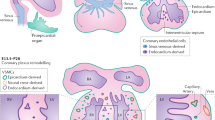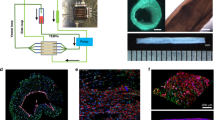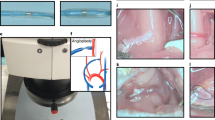Abstract
Cardiovascular and cerebrovascular disease represent the two most common causes of mortality and morbidity in western countries, and the treatment for these is generally by the mechanical restoration of blood flow in the affected tissues. Stimulation of collateral artery growth (arteriogenesis) provides a potential alternative option for the treatment of patients suffering from occlusive artery disease. Therefore, researchers have established several angiogenesis and arteriogenesis animal models to investigate basic mechanisms and pharmacological modulation of collateral artery growth. The authors highlight the most important aspects of vascular growth, discuss different methods and techniques for examining the process, and review the advantages and disadvantages associated with the animal models available for studying this phenomenon.
This is a preview of subscription content, access via your institution
Access options
Subscribe to this journal
We are sorry, but there is no personal subscription option available for your country.
Buy this article
- Purchase on Springer Link
- Instant access to full article PDF
Prices may be subject to local taxes which are calculated during checkout




Similar content being viewed by others
References
Risau, W. Mechanisms of angiogenesis. Nature 386(6626), 671–674 (1997).
Risau, W. & Flamme, I. Vasculogenesis. Annu. Rev. Cell Dev. Biol. 11, 73–91 (1995).
Flamme, I., Frolich, T. & Risau, W. Molecular mechanisms of vasculogenesis and embryonic angiogenesis. J. Cell. Physiol. 173(2), 206–210 (1997).
Asahara, T. et al. Isolation of putative progenitor endothelial cells for angiogenesis. Science 275(5302), 964–967 (1997).
Urbich, C. & Dimmeler, S. Endothelial progenitor cells: characterization and role in vascular biology. Circ. Res. 95(4), 343–353 (2004).
Carmeliet, P. Mechanisms of angiogenesis and arteriogenesis. Nat. Med. 6(4), 389–395 (2000).
Folkman, J. Tumor angiogenesis: therapeutic implications. N. Engl. J. Med. 285(21), 1182–1186 (1971).
Folkman, J. Anti-angiogenesis: new concept for therapy of solid tumors. Ann. Surg. 175(3), 409–416 (1972).
Folkman, J. Tumor angiogenesis: a possible control point in tumor growth. Ann. Intern. Med. 82(1), 96–100. (1975).
Carmeliet, P. et al. Role of HIF-1alpha in hypoxia-mediated apoptosis, cell proliferation and tumour angiogenesis. Nature 394(6692), 485–490 (1998).
Henry, T. et al. Double blind, placebo controlled trial of recombinant human vascular endothelial growth factor: the VIVA trial. J. Am. Coll. Cardiol. 33(2: Supp A), 384 (1999).
Lower, R. Tractus de Corde (Elsevier, Amsterdam, 1669).
Longland, C.J. The collateral circulation of the limb. Ann. Roy. Coll. Surg. Engl. 13(3), 161–164 (1953).
Ito, W.D. et al. Angiogenesis but not collateral growth is associated with ischemia after femoral artery occlusion. Am. J. Physiol. 273 (3 Pt 2), H1255–H1265 (1997).
Deindl, E. et al. Role of ischemia and of hypoxia-inducible genes in arteriogenesis after femoral artery occlusion in the rabbit. Circ. Res. 89(9), 779–786 (2001).
Hoefer, I.E. et al. Arteriogenesis proceeds via ICAM-1/Mac-1- mediated mechanisms. Circ. Res. 94(9), 1179–1185 (2004).
Scholz, D. et al. Expression of adhesion molecules is specific and time-dependent in cytokine-stimulated endothelial cells in culture. Cell Tissue Res. 284(3), 415–423 (1996).
Scholz, D. et al. Ultrastructure and molecular histology of rabbit hindlimb collateral artery growth (arteriogenesis). Virchows Arch. 436(3), 257–270 (2000).
van Royen, N. et al. CD44 regulates arteriogenesis in mice and is differentially expressed in patients with poor and good collateralization. Circulation 109(13), 1647–1652 (2004).
Arras, M. et al. Monocyte activation in angiogenesis and collateral growth in the rabbit hindlimb. J. Clin. Invest. 101(1), 40–50 (1998).
Ley, K., Allietta, M., Bullard, D.C. & Morgan, S. Importance of E-selectin for firm leukocyte adhesion in vivo. Circ. Res. 83(3), 287–294 (1998).
Kukreti, S., Konstantopoulos, K., Smith, C.W. & McIntire, L.V. Molecular mechanisms of monocyte adhesion to interleukin-1β-stimulated endothelial cells under physiologic flow conditions. Blood 89(11), 4104–4111 (1997).
Languino, L.R. et al. Regulation of leukocyte-endothelium interaction and leukocyte transendothelial migration by intercellular adhesion molecule 1-fibrinogen recognition. Proc. Natl. Acad. Sci. USA 92(5), 1505–1509 (1995).
Morigi, M. et al. Fluid shear stress modulates surface expression of adhesion molecules by endothelial cells. Blood 85(7), 1696–1703 (1995).
Cai, W. et al. Altered balance between extracellular proteolysis and antiproteolysis is associated with adaptive coronary arteriogenesis. J. Mol. Cell. Cardiol. 32(6), 997–1011 (2000).
Cai, W.J. et al. Remodeling of the adventitia during coronary arteriogenesis. Am. J. Physiol. Heart Circ. Physiol. 284(1), H31–H40 (2003).
Scholz, D. et al. Early events in adaptive arteriogenesis. (Abstr.) J. Mol. Cell. Cardiol. 30(Suppl), A127 (1998).
Hoefer, I., van Royen, N., Buschmann, I., Piek, J. & Schaper, W. Time course of arteriogenesis following femoral artery occlusion in the rabbit. Cardiovasc. Res. 49(3), 609–617 (2001).
Pipp, F. et al. Elevated fluid shear stress enhances postocclusive collateral artery growth and gene expression in the pig hind limb. Arterioscler. Thromb. Vasc. Biol. 24(9), 1664–1668 (2004).
Unger, E.F. Experimental evaluation of coronary collateral development. Cardiovasc. Res. 49(3), 497–506 (2001).
Rentrop, K.P., Feit, F., Sherman, W. & Thornton, J.C. Serial angiographic assessment of coronary artery obstruction and collateral flow in acute myocardial infarction. Report from the second Mount Sinai-New York University Reperfusion Trial. Circulation 80(5), 1166–1175 (1989).
Fuchs, S., Shou, M., Baffour, R., Epstein, S.E. & Kornowski, R. Lack of correlation between angiographic grading of collateral and myocardial perfusion and function: implications for the assessment of angiogenic response. Coron. Artery Dis. 12(3), 173–178 (2001).
Heil, M. et al. Blood monocyte concentration is critical for the enhancement of collateral artery growth. Am. J. Physiol. Heart Circ. Physiol. 28(6), H2411–H2419 (2002).
Rivard, A. et al. Age-dependent impairment of angiogenesis. Circulation 99(1), 111–120 (1999).
Silvestre, J.S. et al. Antiangiogenic effect of angiotensin II type 2 receptor in ischemia-induced angiogenesis in mice hindlimb. Circ. Res. 90(10), 1072–1079 (2002).
Schirmer, S.H. et al. Differential effects of MCP-1 and leptin on collateral flow and arteriogenesis. Cardiovasc. Res. 64(2), 356–364 (2004).
Wright, C.E., Angus, J.A. & Korner, P.I. Vascular amplifier properties in renovascular hypertension in conscious rabbits. Hypertension 9(2), 122–131 (1987).
Buschmann, I.R. et al. Invasive and non-invasive evaluation of spontaneous arteriogenesis in a novel porcine model for peripheral arterial obstructive disease. Atherosclerosis 167(1), 33–43 (2003).
Voskuil, M. et al. Modulation of collateral artery growth in a porcine hindlimb ligation model using MCP-1. Am. J. Physiol. Heart Circ. Physiol. 284(4), H1422–H1428 (2003).
Chien, G.L., Anselone, C.G., Davis, R.F. & Van Winkle, D.M. Fluorescent vs. radioactive microsphere measurement of regional myocardial blood flow. Cardiovasc. Res. 30(3), 405–412 (1995).
Van Oosterhout, M.F., Prinzen, F.W., Sakurada, S., Glenny, R.W. & Hales, J.R.S. Fluorescent microspheres are superior to radioactive microspheres in chronic blood flow measurements. Am. J. Physiol. 275 (1 Pt 2), H110–H115 (1998).
Buckberg, G. Studies of regional coronary flow using radioactive microspheres. Ann. Thorac. Surg. 20(1), 46–51 (1975).
Bassingthwaighte, J.B. et al. Validity of microsphere depositions for regional myocardial flows. Am. J. Physiol. 253 (1 Pt 2), H184–H193 (1987).
Glenny, R.W. Manual for Using Fluorescent Microspheres to Measure Regional Organ Perfusion (Fluorescent Microsphere Resource Center, Seattle, WA, 1996).
Yang, H.T., Ogilvie, R.W. & Terjung, R.L. Heparin increases exercise-induced collateral blood flow in rats with femoral artery ligation. Circ. Res. 76(3), 448–456 (1995).
Yang, H.T., Laughlin, M.H. & Terjung, R.L. Prior exercise training increases collateral-dependent blood flow in rats after acute femoral artery occlusion. Am. J. Physiol. Heart Circ. Physiol. 279(4), H1890–H1897 (2000).
Prior, B.M., Lloyd, P.G., Yang, H.T. & Terjung, R.L. Exercise-induced vascular remodeling. Exerc. Sport Sci. Rev. 31(1), 26–33 (2003).
Scholz, D. et al. Contribution of arteriogenesis and angiogenesis to postocclusive hindlimb perfusion in mice. J. Mol. Cell. Cardiol. 34(7), 775–787 (2002).
Heil, M. et al. Collateral artery growth (arteriogenesis) after experimental arterial occlusion is impaired in mice lacking CC-chemokine receptor-2. Circ. Res. 94(5), 671–677 (2004).
Horvath, K.A. et al. Myocardial functional recovery after fibroblast growth factor 2 gene therapy as assessed by echocardiography and magnetic resonance imaging. Ann. Thorac. Surg. 74(2), 481–486; discussion 487 (2002).
Wagner, S., Helisch, A., Bachmann, G. & Schaper, W. Time-of-flight quantitative measurements of blood flow in mouse hindlimbs. J. Magn. Reson. Imaging 19(4), 468–474 (2004).
Wagner, S., Helisch, A., Ziegelhoeffer, T., Bachmann, G. & Schaper, W. Magnetic resonance angiography of collateral vessels in a murine femoral artery ligation model. NMR Biomed. 17(1), 21–27 (2004).
Pipp, F. et al. VEGFR-1-selective VEGF homologue PlGF is arteriogenic: evidence for a monocyte-mediated mechanism. Circ. Res. 92(4), 378–385 (2003).
van Royen, N. et al. Local monocyte chemoattractant protein-1 therapy increases collateral artery formation in apolipoprotein E-deficient mice but induces systemic monocytic CD11b expression, neointimal formation, and plaque progression. Circ. Res. 92(2), 218–225 (2003).
Scholz, D. et al. Bone marrow transplantation abolishes inhibition of arteriogenesis in placenta growth factor (PlGF)−/− mice. J. Mol. Cell. Cardiol. 35(2), 177–184 (2003).
Ito, W.D. et al. Monocyte chemotactic protein-1 increases collateral and peripheral conductance after femoral artery occlusion. Circ. Res. 80(6), 829–837 (1997).
van Royen, N. et al. Exogenous application of transforming growth factor-β1 stimulates arteriogenesis in the peripheral circulation. FASEB J. 16(3), 432–434 (2002).
Grundmann, S. et al. Anti-tumor necrosis factor-α therapies attenuate adaptive arteriogenesis in the rabbit. Am. J. Physiol. Heart Circ. Physiol. 289(4), H1497–H1505 (2005).
Kopelman, D., Hirshhorn, G. & Hashmonai, M. Prevention of limb loss in critical ischaemia by arterialization of the superficial venous system: an experimental study in dogs. Cardiovasc. Surg. 6(4), 384–388 (1998).
Rakue, H. et al. Low-dose basic fibroblast growth factor and vascular endothelial growth factor for angiogenesis in canine acute hindlimb insufficiency. Jpn. Circ. J. 62(12), 933–939 (1998).
Herzog, S., Sager, H., Khmelevski, E., Deylig, A. & Ito, W.D. Collateral arteries grow from preexisting anastomoses in the rat hindlimb. Am. J. Physiol. Heart Circ. Physiol. 283(5), H2012–H2020 (2002).
Yang, H.T., Deschenes, M.R., Ogilvie, R.W. & Terjung, R.L. Basic fibroblast growth factor increases collateral blood flow in rats with femoral arterial ligation. Circ. Res. 79(1), 62–69 (1996).
Kondo, T. & Watanabe, Y. A heritable hyperlipemic rabbit [in Japanese]. Jikken Dobutsu. 24(3), 89–94 (1975).
Zhang, S.H., Reddick, R.L., Piedrahita, J.A. & Maeda, N. Spontaneous hypercholesterolemia and arterial lesions in mice lacking apolipoprotein E. Science 258(5081), 468–471 (1992).
Plump, A.S. et al. Severe hypercholesterolemia and atherosclerosis in apolipoprotein E-deficient mice created by homologous recombination in ES cells. Cell 71(2), 343–353 (1992).
van Royen, N. et al. Effects of local MCP-1 protein therapy on the development of the collateral circulation and atherosclerosis in Watanabe hyperlipidemic rabbits. Cardiovasc. Res. 57(1), 178–185 (2003).
Author information
Authors and Affiliations
Corresponding author
Ethics declarations
Competing interests
Hoefer and van Royen are shareholders of Perfusion Technologies GmbH, Freiburg, Germany.
Rights and permissions
About this article
Cite this article
Hoefer, I., van Royen, N. & Jost, M. Experimental models of arteriogenesis: differences and implications. Lab Anim 35, 36–44 (2006). https://doi.org/10.1038/laban0206-36
Received:
Accepted:
Issue Date:
DOI: https://doi.org/10.1038/laban0206-36
This article is cited by
-
The role of thrombospondins in wound healing, ischemia, and the foreign body reaction
Journal of Cell Communication and Signaling (2009)



